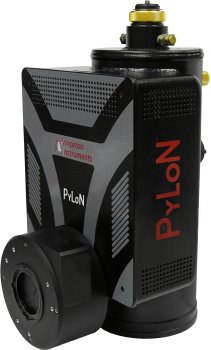Princeton Instruments is pleased to introduce the PyLoN™ series, a brand new line of controllerless, cryogenically cooled CCD cameras designed for quantitative spectroscopy applications that demand the highest possible sensitivity. The first commercially available models in the new series are the PyLoN:100 and PyLoN:400, dual-amplifier cameras that utilize 1340x100 and 1340x400 sensors, respectively. Soon-to-be-introduced models include the dual-amplifier PyLoN: 2K and the single-amplifier PyLoN: 256.
In creating the new PyLoN platform, Princeton Instruments redesigned its industry-leading Spec-10 family of cameras to remove the external controller, increasing experimental flexibility while further improving the ultra-low-noise electronics. Liquid nitrogen cooling in the new cameras virtually eliminates dark current and indium metal seals enhance vacuum longevity. Binning noise has been further reduced from the already low levels in PI’s Spec-10 platform.
 The new PyLoN™ series controllerless, cryogenically cooled CCD cameras designed for quantitative spectroscopy applications from Princeton Instruments.
The new PyLoN™ series controllerless, cryogenically cooled CCD cameras designed for quantitative spectroscopy applications from Princeton Instruments.
“Both new PyLoN cameras provide dual amplifiers and software-selectable gains that permit operation either in high-sensitivity mode, which is ideal for applications such as Raman or single-molecule spectroscopy, or in high-capacity mode, which is well suited to applications like fluorescence spectroscopy,” notes Ed Gooding, Ph.D., spectroscopy product manager at Princeton Instruments. “Additionally, the 2 mm array height of the PyLoN:100 facilitates rapid spectral acquisition, whereas the 8 mm array height of the PyLoN:400 is perfect for multiplexed spectroscopy.”
The CCDs utilized in the PyLoN:100 and PyLoN:400 cameras each feature 20x20 ìm pixels, offering researchers an optimal combination of high resolution and wide dynamic range. Select PyLoN cameras also feature Princeton Instruments’ exclusive eXcelon™ technology, which delivers the highest available sensitivity in the UV and NIR while suppressing the etaloning that occurs in standard back-illuminated CCDs.
The PyLoN platform delivers analog-to-digital conversion (ADC) rates of up to 4 MHz, with digital bias stabilization and correlated double sampling for decreased read noise and improved linearity. Kinetics mode allows microsecond-resolved kinetic spectral acquisition; custom sensor mode increases control over the camera readout, enabling spectral rates in excess of 1000 frames per second.
PyLoN cameras operate on 32-bit and 64-bit Microsoft® Windows® operating systems and are fully supported by LightField™, Princeton Instruments’ advanced 64-bit data acquisition software featuring patent-pending IntelliCal™ wavelength and intensity calibration packages. The latest Gigabit Ethernet (GigE) interface allows remote camera operation via a single cable without the need for custom frame grabbers. PyLoN cameras are available with or without a 40 mm shutter.